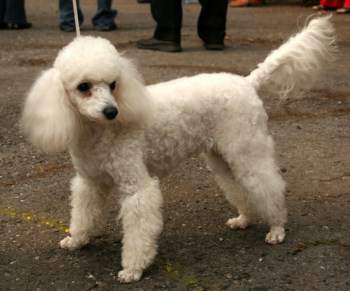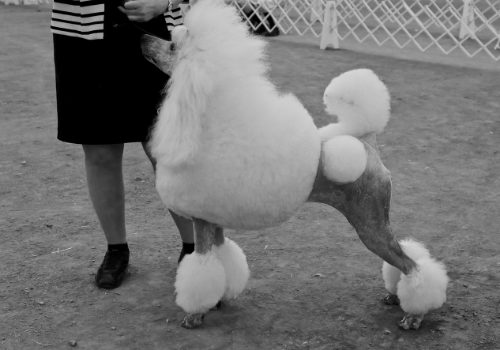Have you ever wondered why poodle tails are often docked? It turns out there are a few reasons behind this common practice in the poodle breed. Docking, the removal of part of the tail, has been a long-standing tradition for poodles, but why is it done?
Historically, poodle tails were docked for practical reasons. One of the main purposes was to prevent injury. Poodles were originally bred as water retrievers, and their tails would often get caught in underwater obstacles or tangled in dense vegetation. Docking the tail reduced the risk of accidents and ensured the poodles could perform their tasks efficiently. This practice has continued even in modern times, although opinions on tail docking have become more varied and debated.
Professional breeders historically dock poodle tails to prevent injury during hunting and retrieving activities. As poodles were used as water retrievers, a docked tail prevented tails from getting tangled in underbrush or caught in bushes. Today, tail docking in poodles is often done for aesthetic purposes, reflecting breed standards. However, the practice has become controversial, with many organizations advocating against it. Some countries have even banned tail docking altogether. It’s important to research and consider all perspectives before making a decision regarding tail docking.

Why are Poodle Tails Docked?
The practice of docking the tails of poodles has been a subject of debate and controversy. While some argue that it is a necessary procedure for the well-being and aesthetics of the breed, others believe it to be unnecessary and cruel. In this article, we will explore the reasons behind why poodle tails are docked and delve into the various perspectives surrounding this practice.
1. The History of Docking Poodle Tails
Tail docking in poodles can be traced back to the breed’s origins as a water retrieving dog. It was believed that by removing a portion of their tail, poodles would be less prone to injury while swimming and retrieving waterfowl. This practice was especially common in poodles used for hunting and working purposes.
Over time, tail docking became a standard practice in poodles, even for those not involved in working roles. It was primarily done for aesthetic reasons, as a docked tail was considered to enhance the breed’s appearance and portray a more polished and refined look.
However, as societal attitudes towards animal welfare have evolved, the justification for docking poodle tails has come into question. Many countries and organizations now prohibit or strongly discourage the practice, deeming it unnecessary and an infringement on the dog’s natural anatomy.
2. The Aesthetic Appeal of Docked Tails
One of the main reasons behind the continued practice of tail docking in poodles is the aesthetic appeal it provides. The shorter tail is believed to exhibit elegance, balance, and a symmetrical appearance that is highly desired in the breed.
Poodles with docked tails are often favored in dog shows and competitions, where adherence to breed standards and physical appearance plays a significant role in judging. The docked tail is seen as a defining characteristic that sets poodles apart and contributes to their graceful and dignified presence.
However, it is important to note that opinions on tail docking and what is considered aesthetically pleasing can vary widely. Growing awareness about the importance of natural and unaltered body structures in dogs has led to a shift in preferences, with many advocating for the acceptance of non-docked poodle tails.
3. Health and Safety Considerations
Another argument in favor of tail docking in poodles is the potential health and safety benefits it may offer. Proponents claim that a shorter or absent tail reduces the risk of injury, particularly in active and energetic dogs.
By removing the tail, poodles are less likely to experience tail fractures, hematomas, or other tail-related injuries. This is especially relevant for working and hunting dogs that may be exposed to rough terrain, dense vegetation, or potential accidents during their duties.
However, it is essential to note that there is limited scientific evidence to support these claims. The American Veterinary Medical Association (AVMA) states that the risk of tail injuries in dogs is relatively low, and tail docking should not be routinely performed for preventive purposes.
4. Ethical Concerns and Legal Restrictions
The practice of docking poodle tails has raised ethical concerns and led to legal restrictions in many countries. The removal of a dog’s body part without a compelling medical reason is considered an unnecessary and potentially painful procedure.
In several jurisdictions, tail docking is considered illegal unless performed for therapeutic purposes or carried out by a licensed veterinarian. Animal welfare organizations and veterinary associations advocate for breeders, owners, and professionals to prioritize the well-being and natural integrity of dogs.
5. Evolving Attitudes and Practices
The attitudes towards tail docking in poodles are gradually changing. As awareness and understanding of animal welfare grow, more and more people are opting for natural and unaltered tails in their poodles.
Many responsible breeders have abandoned tail docking and are focused on producing healthy poodles with intact tails. Dog shows and competitions are also starting to embrace non-docked poodles, emphasizing the importance of breed standard adherence without the need for artificially altered appearances.
It is important to note that tail docking is still practiced in some regions and segments of the poodle breeding community. The decision to dock or not dock a poodle’s tail ultimately lies with the owner, who should carefully consider the impacts, legalities, and ethical implications associated with the procedure.
Conclusion
The practice of docking poodle tails has a long history rooted in both practical and aesthetic considerations. While proponents argue for its potential benefits in terms of appearance, health, and safety, the ethical concerns and evolving attitudes towards animal welfare have led to a decline in its prevalence.
As responsible owners and advocates for poodles, it is important to stay informed about the various perspectives surrounding tail docking and make choices that prioritize the well-being and natural integrity of these beloved dogs.
Key Takeaways: Why Are Poodle Tails Docked?
1. Poodle tails are docked for historical reasons and practical purposes.
2. Historically, docking tails was done to prevent injury during hunting and working activities.
3. Docking is also done for aesthetic reasons, as it is a traditional characteristic of the breed.
4. Many countries have implemented bans or restrictions on tail docking due to ethical concerns.
5. The decision to dock a poodle’s tail should be carefully considered, taking into account the dog’s well-being and legal regulations.
Frequently Asked Questions
Here are some common questions and answers about why poodle tails are docked:
1. What is tail docking in poodles?
Tail docking is a surgical procedure where a portion of a dog’s tail is removed, usually when they are just a few days old. In the case of poodles, their tails are typically docked to a specific length based on breed standards. This process is done for various reasons, including cosmetic purposes, hygiene, and historical traditions.
The length of a poodle’s docked tail can vary depending on the specific poodle breed. For example, standard poodles often have longer docked tails, while miniature and toy poodles may have shorter docked tails. It’s important to note that tail docking is a controversial practice and is banned or restricted in some countries due to concerns about animal welfare.
2. Why are poodle tails docked?
The practice of docking poodle tails has historical roots in their working origins. Poodles were originally bred as water retrievers and their tails were docked to prevent injury while swimming and retrieving game. Docking the tail reduced the risk of the tail getting caught in underwater vegetation or being injured by rough terrain during land retrieves.
In modern times, the primary reasons for docking poodle tails are cosmetic and breed standards. The appearance of a docked tail is considered a distinguishing feature of poodles and is often preferred in dog shows and competitions. Additionally, some believe that a docked tail contributes to the overall balance and elegance of a poodle’s appearance.
3. Are poodles born with docked tails?
No, poodles are not born with docked tails. Tail docking is typically performed within the first few days of a poodle puppy’s life. The procedure is done by a veterinarian using sterile instruments and is usually quick and painless. It’s important to note that tail docking should only be done by a trained professional in a safe and controlled environment.
It’s also worth mentioning that not all poodles have their tails docked. In some countries, tail docking is banned or highly regulated, and poodles are allowed to keep their natural tails. In these cases, the natural tail of a poodle can be curly and fluffy, adding to their unique appearance.
4. Does tail docking affect a poodle’s health or behavior?
There is ongoing debate regarding the effects of tail docking on a poodle’s health and behavior. Some argue that tail docking can lead to pain, discomfort, and potential complications. Others believe that when done properly and at an early age, poodles do not experience long-term negative effects.
It’s important to note that tail docking is considered an elective procedure and is not medically necessary for a poodle’s well-being. If you’re considering getting a poodle or already have a poodle with a docked tail, it’s essential to provide proper care, attention, and regular veterinary check-ups to ensure their overall health and happiness.
5. Are there any alternatives to tail docking for poodles?
Yes, there are alternatives to tail docking for poodles. One alternative is leaving the tail undocked, allowing the poodle to keep its natural tail. However, this may not be in line with breed standards for certain poodle varieties.
Another alternative is a procedure called tail banding, where a tight band is placed at the base of the tail when the puppy is very young. This restricts blood flow to the tail, causing it to naturally fall off over time. Tail banding is considered less invasive than tail docking, but it should still be done by a professional and with caution.

So why are poodle tails docked? The primary reason is tradition and aesthetic preference.
In the past, poodles were working dogs and docking tails was done to prevent injuries. However, today, tail docking is mostly done for cosmetic reasons, to conform to breed standards and give poodles their distinct look.
